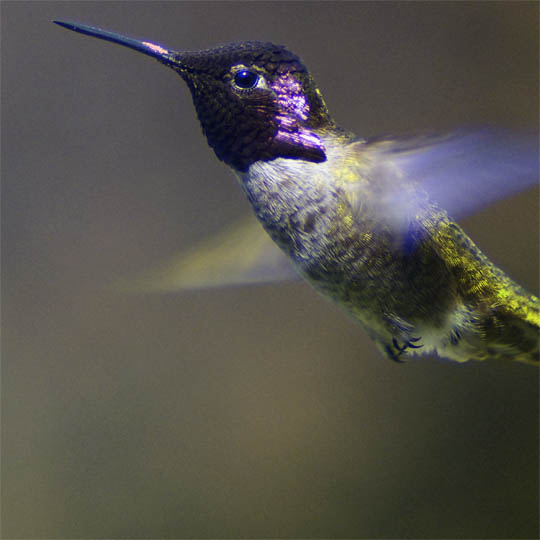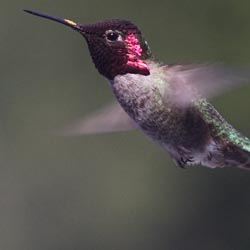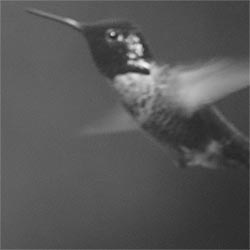| Ultraviolet Bird Photography |
| ABOUT IMAGES BIRD VISION VIDEOS |

 combined ultraviolet and visible light |
 visible light |
|
 ultraviolet |

© Nathan Chronister for permission
Here are all of the captions from the slides shown above:
The irridescent display feathers of Anna's hummingbird reflect red and ultraviolet light, giving them a hidden dimension of color that is not visible to humans. The main photo represents what birds might see. It's a combination of the ultraviolet and visible light images. Unlike Anna's hummingbird, the ruby throated hummingbird throat feathers do not reflect UV light. The presence or absence of UV reflectance might help hummingbirds recognize their own species.
The flamingo also reflects UV light. As with the hummingbird, the combination of red and UV shows up as purple in the main photo. Read the "about" link above for an explanation of how this works. Unlike the flamingo, the red on this blackbird appears dark in the UV photo. The blackbird has different red pigments, which absorb more UV light.
The same thing happens with yellow pigments in birds. The yellow belly of the plush-crested jay reflects ultraviolet, causing it to show up as pink in the combined photo. But not all yellows are the same. The eye also appears yellow to us, but in the UV photo it's totally dark (except for the highlight). Birds would see the eye and the belly feathers as two different colors!
This is an alternative presentation of the plush-crested jay, in which I have used a pattern of dots to indicate which areas are reflecting ultraviolet light. This makes it possible to show the UV information, without altering the visible light colors.
In contrast to the plush-crested jay, the yellow on this toucan appears quite dark in the ultraviolet. This is indicated by the lack of pink color in the combined photo. The bare skin around the eye has some UV reflectance.
This photo shows hidden UV coloration in both the chicory flower and the goldfinch. The back of the bird is more UV reflective, compared with the cheek and belly.
Blue color in birds is caused by the microscopic structure of the feathers, instead of blue pigments. In most cases, like this western bluebird, the UV reflectance follows the same pattern as the blue light reflectance. The indigo bunting is another example.
The blue-bellied roller is an exception. It has three different shades of blue, and the very dark blue of the belly is quite bright in the ultraviolet. The blue back of this trogon doesn't reflect much UV, causing it to appear green in the combined photo.
White feathers always reflect UV. Black or brown feathers are always UV-dark. The striking black and white pattern of the red-bellied woodpecker is exactly the same in ultraviolet or visible light.
In this green-winged macaw, the beak and the facial skin both look almost white, to the human eye, but the beak does not reflect as much ultraviolet light. Birds will likely perceive two different colors. The common parakeet or budgie has some interesting UV features. There is a small UV reflective patch on the chin, which appears dark violet to humans. Notice also, unlike most yellow birds, the yellow feathers on the head of the parakeet strongly absorb ultraviolet light.